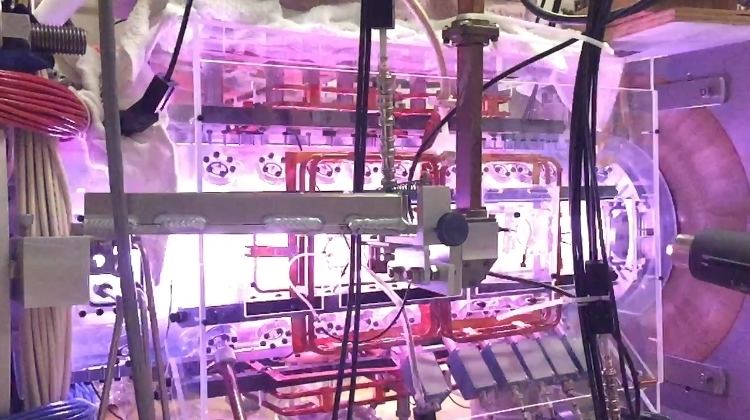 | ||
The Princeton Field-Reversed Configuration experiment (PFRC) is a plasma physics experiment at the Princeton Plasma Physics Laboratory (PPPL). The experiment probes the dynamics of long-pulse, collisionless, low s-parameter field-reversed configurations formed with odd-parity rotating magnetic fields. It aims to experimentally verify the physics predictions that such configurations are globally stable and have transport levels comparable with classical magnetic diffusion.
Contents
Odd-Parity Rotating Magnetic Field
The electrical current that forms the FRC in the PFRC is driven by a rotating magnetic field (RMF). This technique has been well-studied and produced favorable results in the Rotamak series of experiments. However, rotating magnetic fields as applied in these and other experiments (so-called "even parity RMFs") induce opening of the magnetic field lines. When a transverse magnetic field is applied to the axisymmetric equilibrium FRC magnetic field, rather than magnetic field lines closing on themselves and forming a closed region, they spiral around in the azimuthal direction and ultimately cross the separatrix surface which contains the closed FRC region.
The PFRC uses RMF antennae which produce a magnetic field which changes direction about a symmetry plane oriented with its normal along the axis, half-way along the length of the axis of the machine. This configuration is called an "odd parity" rotating magnetic field. Such magnetic fields, when added to axisymmetric equilibrium magnetic fields, do not cause opening of the magnetic field lines. Thus the RMF is not expected to contribute to transport of particles and energy out of the core of the PFRC.
Low s-Parameter
In an FRC, the name s-parameter is given to the ratio of the distance between the magnetic null and the separatrix, and the thermal ion Larmor radius. That is how many ion orbits can fit between the core of the FRC and where it meets the bulk plasma. A high-s FRC would have very small ion gyroradii compared to the size of the machine. Therefore, at high s-parameter, the model of Magnetohydrodynamics (MHD) applies. MHD predicts that the FRC is unstable to the "n=1 tilt mode," in which the reversed field tilts 180 degrees to align with the applied magnetic field, destroying the FRC.
A low-s FRC is predicted to be stable to the tilt mode. An s-parameter less than or equal to 2 is sufficient for this effect. However, only two ion radii between the hot core and the cool bulk means that on average only two scattering periods (velocity changes of on average 90 degrees) are sufficient to remove a hot, fusion-relevant ion from the core of the plasma. Thus the choice is between high s-parameter ions that are classically well confined but convectively poorly confined, and low s-parameter ions that are classically poorly confined but convectively well confined.
The PFRC has an s-parameter between 1 and 2. The stabilization of the tilt-mode is predicted to aid confinement more than the small number of tolerable collisions will hurt confinement.
